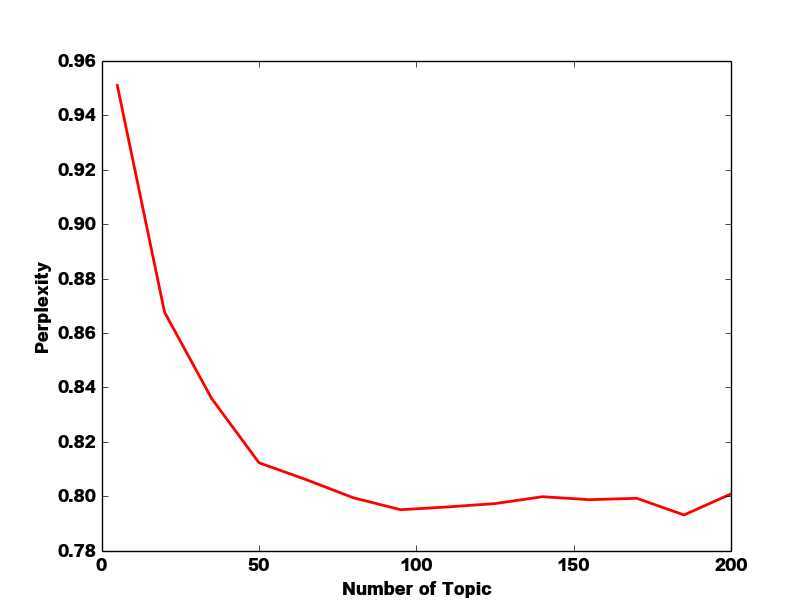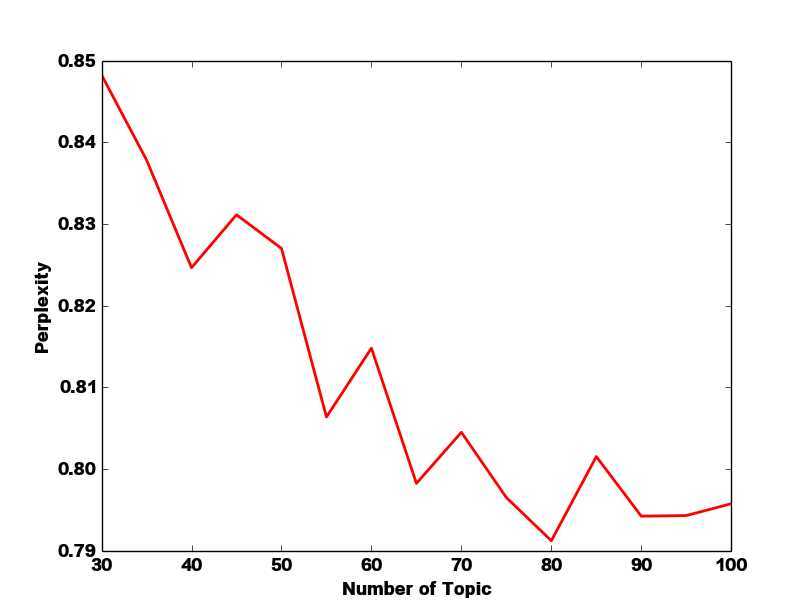标签:style blog http color width 2014
转载请注明:电子科技大学EClab——落叶花开http://www.cnblogs.com/nlp-yekai/p/3816532.html
困惑度一般在自然语言处理中用来衡量训练出的语言模型的好坏。在用LDA做主题和词聚类时,原作者D.Blei就是采用了困惑度来确定主题数量。文章中的公式为:
perplexity=exp^{ - (∑log(p(w))) / (N) }
其中,P(W)是指的测试集中出现的每一个词的概率,具体到LDA的模型中就是P(w)=∑z p(z|d)*p(w|z)【z,d分别指训练过的主题和测试集的各篇文档】。分母的N是测试集中出现的所有词,或者说是测试集的总长度,不排重。
因而python程序代码块需要包括几个方面:
1.对训练的LDA模型,将Topic-word分布文档转换成字典,方便查询概率,即计算perplexity的分子
2.统计测试集长度,即计算perplexity的分母
3.计算困惑度
4.对于不同的Topic数量的模型,计算的困惑度,画折线图。
python代码如下:
1 # -*- coding: UTF-8-*- 2 import numpy 3 import math 4 import string 5 import matplotlib.pyplot as plt 6 import re 7 8 def dictionary_found(wordlist): #对模型训练出来的词转换成一个词为KEY,概率为值的字典。 9 word_dictionary1={} 10 for i in xrange(len(wordlist)): 11 if i%2==0: 12 if word_dictionary1.has_key(wordlist[i])==True: 13 word_probability=word_dictionary1.get(wordlist[i]) 14 word_probability=float(word_probability)+float(wordlist[i+1]) 15 word_dictionary1.update({wordlist[i]:word_probability}) 16 else: 17 word_dictionary1.update({wordlist[i]:wordlist[i+1]}) 18 else: 19 pass 20 return word_dictionary1 21 22 def look_into_dic(dictionary,testset): #对于测试集的每一个词,在字典中查找其概率。 23 ‘‘‘Calculates the TF-list for perplexity‘‘‘ 24 frequency=[] 25 letter_list=[] 26 a=0.0 27 for letter in testset.split(): 28 if letter not in letter_list: 29 letter_list.append(letter) 30 letter_frequency=(dictionary.get(letter)) 31 frequency.append(letter_frequency) 32 else: 33 pass 34 for each in frequency: 35 if each!=None: 36 a+=float(each) 37 else: 38 pass 39 return a 40 41 42 def f_testset_word_count(testset): #测试集的词数统计 43 ‘‘‘reture the sum of words in testset which is the denominator of the formula of Perplexity‘‘‘ 44 testset_clean=testset.split() 45 return (len(testset_clean)-testset.count("\n")) 46 47 def f_perplexity(word_frequency,word_count): #计算困惑度 48 ‘‘‘Search the probability of each word in dictionary 49 Calculates the perplexity of the LDA model for every parameter T‘‘‘ 50 duishu=-math.log(word_frequency) 51 kuohaoli=duishu/word_count 52 perplexity=math.exp(kuohaoli) 53 return perplexity 54 55 def graph_draw(topic,perplexity): #做主题数与困惑度的折线图 56 x=topic 57 y=perplexity 58 plt.plot(x,y,color="red",linewidth=2) 59 plt.xlabel("Number of Topic") 60 plt.ylabel("Perplexity") 61 plt.show() 62 63 64 topic=[] 65 perplexity_list=[] 66 f1=open(‘/home/alber/lda/GibbsLDA/jd/test.txt‘,‘r‘) 67 testset=f1.read() 68 testset_word_count=f_testset_word_count(testset) #call the function to count the sum-words in testset 69 for i in xrange(14): 70 dictionary={} 71 topic.append(5*(3i+1)) 72 trace="/home/alber/lda/GibbsLDA/jd/stats/model-final-"+str(5*(i+1))+".txt" 73 f=open(trace,‘r‘) 74 text=f.readlines() 75 word_list=[] 76 for line in text: 77 if "Topic" not in line: 78 line_clean=line.split() 79 word_list.extend(line_clean) 80 else: 81 pass 82 word_dictionary=dictionary_found(word_list) 83 frequency=look_into_dic(word_dictionary,testset) 84 perplexity=f_perplexity(frequency,testset_word_count) 85 perplexity_list.append(perplexity) 86 graph_draw(topic,perplexity_list)
下面是画出的折线图,在拐点附近再调整参数(当然与测试集有关,有图为证~~),寻找最优的主题数。实验证明,只要Topic选取数量在其附近,主题抽取一般比较理想。


本人也是新手开始作研究~程序或者其他地方有错误的,希望大家指正。
用python计算lda语言模型的困惑度并作图,布布扣,bubuko.com
标签:style blog http color width 2014
原文地址:http://www.cnblogs.com/nlp-yekai/p/3816532.html